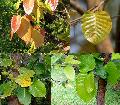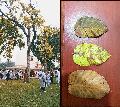|
What is the Real Sal
Tree?
Bhikkhu Nyanatusita
BPS Newsletter, No. 63, 2010
The sāla or sal tree is an important tree in
Buddhism. The twin sal trees in the sal wood of the Mallans near
Kusināra dropped their fragrant flowers upon the Buddha while he was
lying on his deathbed (D II 137-8, S I 157, A II 79, Ud 37, Th 948, Ap I
101). According to the commentary to the Majjhima Nikāya (M-a IV 182),
the Buddha was born in the Sal wood park at Lumbini
(lumbinīsālavanuyyāna); his mother giving birth while standing and
holding the branch of a sal tree.
The important Mūlapariyāyasutta (M I 1), was
taught by the Buddha while sitting at the root of the royal sal tree in
the Subhaga grove at Ukkattha (M I 1 ff). In the Gosinga Sutta,
Sāriputta Thera described the sal wood of GosiKga as follows: “The
GosiKga wood is delightful, the night is moonlit, the sal trees are all
in blossom; it is like heavenly scents are wafting. What kind of Bhikkhu
could illuminate this grove?” (M I 212). The CaKkī Sutta describes how
the Brahmin CaKkī and other Brahmins of Opasāda village visited the
Buddha while he was staying in the nearby sal wood, called the “Gods’
wood” (M II 164). The Brahmin Navakammika went to the Buddha while he
was sitting meditating at the root of a sal tree in a sal wood (S I
179/SN 7:17). The Gavesīsutta (A III 214–18) was taught in a large sal
wood that the Buddha noticed while travelling with a big group of monks
on a road in the Kosala country.
The previous Buddha Vessabhū attained
enlightenment under a great sal tree (D II 4). The tree is also
mentioned in the suttas in relation to its wood, used for making boats
(A II 201). In the Sonaka Jātaka the sal is said to be a delightful tree
with a straight trunk and leaves with a bluish lustre (J V 251).
The sal tree’s Latin name is Shorea robusta.
The sal tree belongs to the Dipterocarpaceae family and is related to
the hora tree (Dipterocarpus zeylanicus) of Sri Lanka. It grows
naturally in the foothills of the Himalaya, such as in Terai region of
Northern India and Southern Nepal, and also in central India in Madhya
Pradesh, Orissa, etc. It can reach 35 meters high with a girth of 2.5m.
Large clusters of small, but pretty, fragrant,
drooping white flowers cover the tree in spring, usually in April,
depending on the altitude. In dry regions it loses its leaves in the dry
season, which lasts from February to April. The seeds are dispersed
through helicopter-like fruits. The wood is renown for its robustness
and durability. Being waterproof it is used as an outdoor wood, for
railway sleepers, bridges, boats, etc, and also indoor for roof-beams,
windows, etc. The resin is used for making wooden boats water proof, as
an astringent and detergent medicine, and as an incense. Sal forests are
prominent in Indian national parks such as the Bandhavgarh and Kanha
tiger reserves in Madhya Pradesh.
In areas with regular forest fires, this
fire-resistant tree grows in open stands with no other kinds of trees
and no or little undergrowth, which would explain why the Buddha and
arahants chose it as a convenient place to stay. The following
description from the World Wildlife Fund describes the sal forest well:
“In the lowland parts of the Terai, you can
sometimes end up in a forest comprising entirely of one tree
species, the majestic sal tree. Standing in a sal forest is a
completely different experience from the nearby diverse and dense
jungles. The tree trunks are long and straight, and there is plenty
of light. During spring, while the sal trees are in blossom, the air
is filled with a strong, sweet and pleasant smell. Sal is a hardwood
species that is unusually resistant to rotting and to attacks of
hungry insects.”
Captain Forsyth, in his High land of Central
India, described the Sal woods of the Kanha reserve as follows:
“Throughout the summer, the glossy
darkgreen foliage of sal reflects the light in a thousand tints, and
first when all other vegetation is at its worst, a few weeks before
the gates of heaven are opened in the annual monsoon, the sal
selects its opportunity of bursting into a fresh garment of the
brightest and softest green.”
In Sri Lanka, Thailand and other Buddhist
countries there is confusion as to the identity of the sal tree. What is
called “sal” in Sri Lanka and Thailand is a beautiful tree with many
large fragrant pink flowers and large, melon-size woody round fruits
hanging from its trunk and branches. This is not Shorea
robusta; instead, it is the cannonball tree, Couroupita
guianensis, native to the jungles of Northeastern South America. It
was introduced to Asia in colonial times, probably as a curiosity by the
plant loving Victorian British. It is quite a different tree from the
sal tree that grows in northern India and Nepal and is not related to
it. There are no reports of cannonball trees forming groves and they are
not growing in the wild in Asia. It is not possible to stay under a
cannonball tree because of the heavy fruits falling down and the fallen,
rotting flowers forming a slippery sludge on the forest floor.
* |







































































































